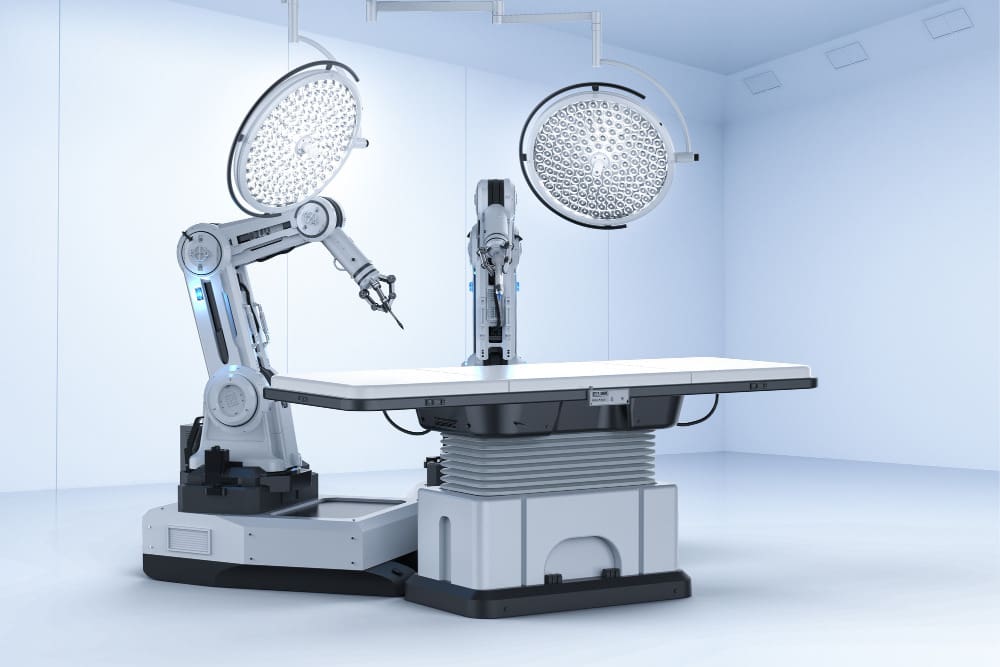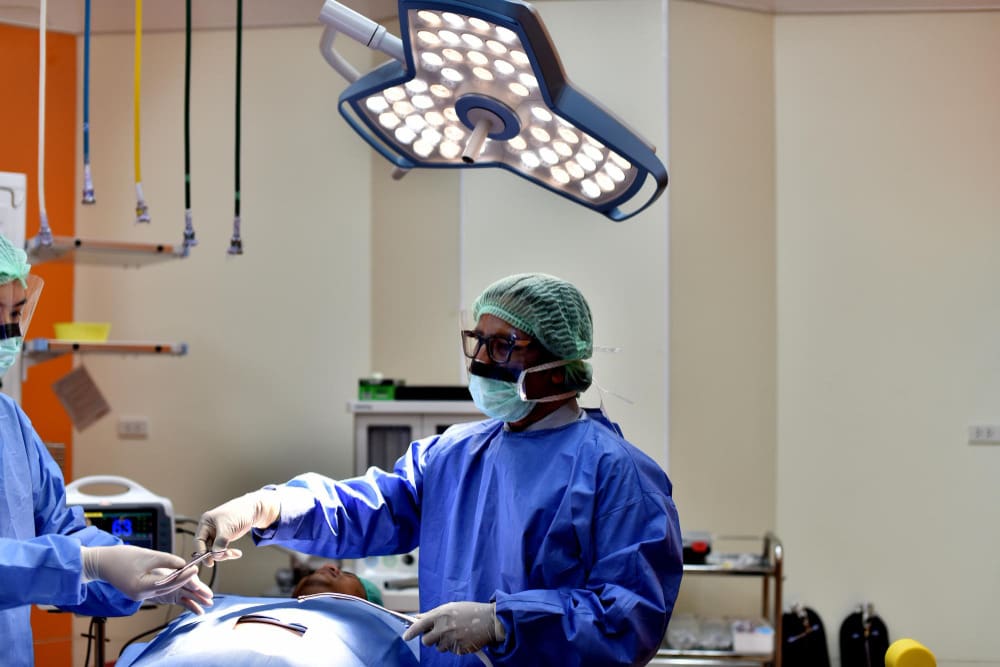Last Updated on November 3, 2025 by mcelik

In 2025, healthcare is changing fast with AI surgery robots in operating rooms. These robots are making surgeries better by being more precise and quick. They also help patients heal faster and get better results.. At Liv Hospital, we lead in using these advanced tools for better care. We focus on care that is reliable, cutting-edge, and patient-focused.
As AI doing surgery grows, it’s important to know the key facts. In this article, we’ll look at seven key facts about AI surgery robots. We’ll see how they’re changing healthcare today.

Surgical robotics has changed a lot, from the first ideas to today’s AI systems. These changes have made surgeries more precise and better for patients.
The start of surgical robots was a big step forward. At first, these robots helped with tough surgeries, giving surgeons better control and views. Robotic surgery gallbladder removal was one of the first uses, showing how robots could help in surgery.
Robot technology has gotten much better, with new systems that can do more surgeries. These early robots helped pave the way for today’s advanced AI robots.
| Feature | Early Robotic Systems | Modern AI-Powered Systems |
|---|---|---|
| Precision | Limited by mechanical constraints | Enhanced with AI-driven algorithms |
| Autonomy | Minimal; required constant human input | Increased; capable of real-time decision support |
| Applications | Limited to specific procedures | Expanded to various surgical specialties |
The move to AI-powered robots is a big step. AI surgery robots now do complex tasks, like precise control and making quick decisions. This helps surgeons do their jobs better.
AI is changing surgery, making ai robotic surgery more common. These systems are making surgeries better and helping patients recover faster.
The future of surgical robots looks bright, with AI and machine learning getting better. As we keep improving ai surgery robots, we’ll see even more new uses in surgery.

By 2025, the market for AI surgical robots is set to grow a lot. It’s expected to hit $7.7–8.02 billion. This growth comes from better AI tech, more use in hospitals, and big investments in robotics.
The value of AI surgical robots shows investors believe in this tech. The market is growing fast, both in value and in how it’s used. AI in robotic surgery makes surgeries more precise, cuts down recovery times, and boosts patient results.
AI is making surgery more realistic and precise. This change is because of the need for better, less invasive surgeries.
| Year | Market Valuation (in Billion $) | Growth Rate (%) |
|---|---|---|
| 2023 | 5.5 | 12 |
| 2024 | 6.8 | 15 |
| 2025 | 7.7-8.02 | 18 |
Big names like Intuitive Surgical Inc., Medtronic, and Stryker Corporation are leading in surgical robotics. They’re making advanced AI robots that are changing surgery. For example, recent investments in Intuitive Surgical show growing interest in this field.
Investments in AI surgical tech are going up. Venture capitalists and health groups are pouring money into startups and big companies. This money helps develop AI and robotic systems for complex surgeries. We’re seeing a lot more funding for AI-powered surgical robots.
AI has made surgical robots better at handling tough surgeries. This is thanks to three main things: precise control, real-time help, and working well with imaging tech.
AI surgery robots can now control and move with great precision. This is key for robotic assisted gallbladder surgery, where mistakes can be deadly. Their advanced skills let surgeons do complex tasks with less chance of error.
AI robots also come with systems that give surgeons quick advice during surgery. These systems look at patient data and live images to help surgeons make fast, smart choices. This makes complex surgeries easier to handle.
AI robots work with top-notch imaging tech for clearer views during surgery. This helps surgeons see the patient’s body better, leading to more precise surgeries. This combo is a game-changer for surgeries that need detailed views, like brain and bone operations.
As AI in surgery robots keeps improving, they’ll play an even bigger part in surgery. Their ability to be precise, offer quick advice, and work with imaging tech is changing surgery for the better. This means better care for patients all over the world.
By 2025, over 2,100 surgical robots will be in use worldwide. This shows how much we rely on robots to improve surgery. They help make operations more precise and better for patients.
The spread of surgical robots is not even. North America and Europe lead in using these robots. They have better healthcare systems and invest a lot in medical tech.
In the Asia-Pacific regions, countries like China and Japan are catching up. They are making big steps in robotic surgery.
How fast robots are adopted varies by healthcare system. Costs, rules, and who’s trained are big factors. Private healthcare providers often lead in adopting new tech, like robotic surgery.
More robots mean more training places. We’re seeing dedicated training centers for robotic surgery. Surgeons can practice there.
“The key to successful robotic surgery lies not just in the technology itself, but in the hands that operate it. Complete training programs are key to make sure surgeons can use robots well.”
These training spots are vital. They help surgeons learn to do complex surgeries like robotic gallbladder removal surgery safely and effectively.
Robots in the operating room are changing how we do surgery. They offer patients less invasive options and help them heal faster. We’re seeing big improvements in many surgical areas, making patients’ outcomes better and doctors more skilled.
Robotic gallbladder removal surgery is a big win for robotic tech. It’s a small cut approach that lets doctors work with more precision. This means fewer complications and quicker healing times for patients.
In heart and brain surgeries, robots give doctors better control and vision. This means they can do more precise work. It could lead to better results in tough surgeries.
Robots are also helping in bone and women’s health surgeries. They help place implants more accurately and do treatments that are less invasive. This is good news for many conditions.
| Surgical Specialty | Benefits of Robotic Surgery | Improved Outcomes |
|---|---|---|
| Gallbladder Removal | Minimally invasive, precise control | Faster recovery, less scarring |
| Cardiac Surgery | Enhanced dexterity, better visualization | More precise repairs, reduced complications |
| Neurological Surgery | Precision in delicate areas | Improved patient outcomes, reduced risk |
Robotic surgery is changing healthcare, with up to 15% of some surgeries now done by robots. This shows how much doctors trust in robotic-assisted surgery.
Robotic systems are used for many complex surgeries. Robotic gallbladder surgery is one example, helping patients heal faster and feel less pain. Other surgeries, like urology, gynecology, and cardiology, also use robots.
These surgeries are more precise, have fewer complications, and better results for patients.
How much robotic surgery is used varies by region. The U.S. and some European countries are at the forefront. They use robots in many surgeries.
Robotic surgery costs a lot at first, but it’s worth it in the long run. It means shorter hospital stays, less blood loss, and less need for follow-up care. This saves money overall.
| Factor | Robotic Surgery | Traditional Surgery |
|---|---|---|
| Hospital Stay | Shorter | Longer |
| Blood Loss | Less | More |
| Recovery Time | Faster | Slower |
As robotic surgery gets better and more common, we’ll see even better results and lower costs.
The future of surgery is changing with autonomous robotic systems. These systems aim to improve patient care. They are getting better at doing complex surgeries with great precision.
Now, autonomous robotic surgery can handle tasks like robotic surgery gallbladder removal with high accuracy. They use advanced algorithms and real-time data to make decisions during surgery. This could help reduce human mistakes.
AI surgeons are starting to analyze patient data and adjust to surgery needs in real-time. This makes surgeries more realistic and precise, which is key in complex cases.
Safety is a big concern. Autonomous robotic surgery systems have many safety checks. But, human oversight is also key, with surgeons watching and stepping in if needed.
We’re creating strict guidelines and training for surgeons to work with these robots. This ensures they can handle any situation during a surgery.
Creating rules for autonomous robotic surgery is essential. We’re working with regulatory bodies to set clear guidelines. These guidelines will cover development, testing, and use of these systems.
These rules will tackle issues like liability, safety, and performance. They will help make autonomous robotic surgery a standard part of healthcare.
AI in surgery has cut readmission rates by more than half in many cases. This big drop is thanks to AI robots’ precision and steady work in the OR.
Studies show AI robots help surgeries have fewer problems after. For example, gallbladder removal robotic surgery cuts down on recovery time and issues compared to old ways.
AI in surgery has greatly lowered complication rates. AI looks at lots of surgeries’ data to spot and prevent problems, making patients safer.
Patients with AI help in surgery get better faster. This is because many robotic surgeries are less invasive, causing less harm to the patient.
Healthcare uses AI robots to make surgeries safer and more efficient. As AI gets better, we’ll see even better results for patients.
Robotic surgery is changing how patients recover from surgery. It’s making a big difference in surgeries like robotic gallbladder removal surgery. The results are clear.
Robotic assisted gallbladder surgery has many benefits. It’s more precise and less invasive than traditional surgery. This means better results for patients.
People who have gallbladder robotic surgery often feel less pain after. They also get back to their daily activities faster. This is because the surgery is done through smaller cuts, causing less damage.
Robotics in gallbladder surgery means less scarring. The small cuts leave less of a mark. This is a big plus for patients.
The robots also cause less damage to tissues. This leads to quicker healing and fewer problems after surgery.
| Benefits | Traditional Surgery | Robotic Surgery |
|---|---|---|
| Scarring | More noticeable | Less noticeable |
| Tissue Damage | Higher risk | Lower risk |
| Recovery Time | Longer | Shorter |
People who have robotic assisted gallbladder surgery recover faster. This is great for those with busy lives or who need to get back to work quickly.
The benefits include less pain, less scarring, and less tissue damage. These all help patients get back to their normal lives sooner. Gallbladder robotic surgery is a good choice for many.
Robots in surgery bring many benefits, but they face technical, financial, and training hurdles. As we add AI surgical robots to healthcare, we must tackle these challenges. This ensures they work well and help patients get better.
Creating AI surgical robots is tough due to several technical issues. We need to make these robots more precise and reliable. We also have to improve how they process data in real-time and fit with hospital systems.
Key technical challenges:
Doctors and medical staff need special training to use AI surgical robots well. This training is key to getting the most out of robotic surgery and keeping patients safe.
Training needs:
| Challenge | Description | Potential Solution |
|---|---|---|
| Technical Hurdles | Precision, reliability, and integration issues | Advanced R&D, standardized protocols |
| Cost Concerns | High initial and maintenance costs | Financing options, cost-benefit analysis |
| Training Needs | Specialized training for medical staff | Comprehensive training programs, simulation training |
Looking ahead to 2025 and beyond, AI surgical systems are set to change healthcare. The next wave of AI surgery robots will improve precision, safety, and patient results.
Recent breakthroughs have made surgery more realistic with autonomous robotic surgery. This marks a big step towards more advanced medical procedures.
New technologies in surgical robotics are driving innovation. These include better sensors, enhanced imaging, and advanced AI for quick decisions during surgery.
These advancements will boost AI robot surgery. They will allow for more complex surgeries with better precision and accuracy.
The future of AI surgery is tied to working with other AI healthcare systems. This includes electronic health records, diagnostic tools, and personalized medicine platforms. Surgeons will get a lot of data to help them make better decisions and care for patients.
This integration will lead to a more complete approach to patient care. Healthcare providers will be able to offer more tailored and effective treatments.
Another exciting development is remote and telesurgery applications. Thanks to 5G networks and robotic tech, surgeons can do operations from afar. This will make specialized care available in places that need it most.
This tech could change how we get surgical care, even in urgent situations where fast action is key.
As we look ahead to 2025, robots in the operating room are changing healthcare. AI in surgery has been a big leap forward. AI surgical robots can handle tough tasks with great precision.
Robotic surgery has made patient care better, cut down on readmissions, and sped up recovery. By 2025, over 2,100 surgical robots will be used worldwide. This shows how AI robots are becoming more common in surgery.
We’re seeing more innovation in AI surgical robots, which will keep improving patient care. As AI tech gets better, we’ll see even more advanced robots in the OR. This will change healthcare a lot.
The future of surgery is already here, thanks to AI robots. They can do complex surgeries with great accuracy. This is changing how we do surgery.
iData Research. AI Surgical Planning. https://idataresearch.com/ai-surgical-planning/
Sermo. The Future of Robotics in Surgery 2025: Trends. https://www.sermo.com/en-gb/resources/the-future-of-robotics-in-surgery-2025-trends/
The AI-based surgical robots market is set to hit .7–8.02 billion by 2025. This growth is fueled by innovation from key players and big investments in AI surgical tech.
AI surgery robots are making complex surgeries like gallbladder removal more precise. They help reduce recovery times and improve patient results.
Robotic gallbladder surgery has many advantages. It leads to less scarring, quicker recovery, and better patient results.
Yes, autonomous robotic surgery systems are being used. They can handle complex tasks. Safety measures and human oversight are being developed to ensure safe use.
AI surgery can cut readmission rates by over 50%. It also speeds up patient recovery thanks to its advanced capabilities.
Adopting AI surgical robots faces several hurdles. These include technical challenges, cost, and the need for medical staff training.
Beyond 2025, we expect AI surgical systems to evolve. New technologies will lead to more advanced AI surgery. They will also integrate with other AI healthcare systems.
By 2025, over 2,100 surgical robots will be in use globally. The adoption rate varies across different healthcare systems and regions.
Robotic surgery offers many benefits. It leads to faster recovery and better patient results, even though it costs more upfront.
AI is key in improving robotic surgery. It enables precise control, real-time support, and integration with imaging. This leads to better patient outcomes.
Subscribe to our e-newsletter to stay informed about the latest innovations in the world of health and exclusive offers!
WhatsApp us